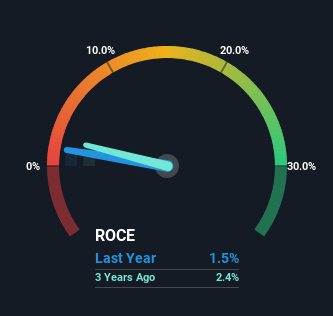- Hong Kong
- /
- Electrical
- /
- SEHK:2727
Shanghai Electric Group (HKG:2727) Has Some Difficulty Using Its Capital Effectively

When it comes to investing, there are some useful financial metrics that can warn us when a business is potentially in trouble. Businesses in decline often have two underlying trends, firstly, a declining return on capital employed (ROCE) and a declining base of capital employed. This combination can tell you that not only is the company investing less, it's earning less on what it does invest. In light of that, from a first glance at Shanghai Electric Group (HKG:2727), we've spotted some signs that it could be struggling, so let's investigate.
Understanding Return On Capital Employed (ROCE)
Just to clarify if you're unsure, ROCE is a metric for evaluating how much pre-tax income (in percentage terms) a company earns on the capital invested in its business. The formula for this calculation on Shanghai Electric Group is:
Return on Capital Employed = Earnings Before Interest and Tax (EBIT) ÷ (Total Assets - Current Liabilities)
0.015 = CN¥1.8b ÷ (CN¥279b - CN¥161b) (Based on the trailing twelve months to March 2024).
So, Shanghai Electric Group has an ROCE of 1.5%. Ultimately, that's a low return and it under-performs the Electrical industry average of 7.2%.
See our latest analysis for Shanghai Electric Group

In the above chart we have measured Shanghai Electric Group's prior ROCE against its prior performance, but the future is arguably more important. If you're interested, you can view the analysts predictions in our free analyst report for Shanghai Electric Group .
What The Trend Of ROCE Can Tell Us
We are a bit worried about the trend of returns on capital at Shanghai Electric Group. Unfortunately the returns on capital have diminished from the 5.1% that they were earning five years ago. On top of that, it's worth noting that the amount of capital employed within the business has remained relatively steady. Companies that exhibit these attributes tend to not be shrinking, but they can be mature and facing pressure on their margins from competition. So because these trends aren't typically conducive to creating a multi-bagger, we wouldn't hold our breath on Shanghai Electric Group becoming one if things continue as they have.
On a side note, Shanghai Electric Group's current liabilities are still rather high at 58% of total assets. This can bring about some risks because the company is basically operating with a rather large reliance on its suppliers or other sorts of short-term creditors. While it's not necessarily a bad thing, it can be beneficial if this ratio is lower.
The Bottom Line On Shanghai Electric Group's ROCE
In the end, the trend of lower returns on the same amount of capital isn't typically an indication that we're looking at a growth stock. It should come as no surprise then that the stock has fallen 39% over the last five years, so it looks like investors are recognizing these changes. That being the case, unless the underlying trends revert to a more positive trajectory, we'd consider looking elsewhere.
If you're still interested in Shanghai Electric Group it's worth checking out our FREE intrinsic value approximation for 2727 to see if it's trading at an attractive price in other respects.
While Shanghai Electric Group may not currently earn the highest returns, we've compiled a list of companies that currently earn more than 25% return on equity. Check out this free list here.
New: Manage All Your Stock Portfolios in One Place
We've created the ultimate portfolio companion for stock investors, and it's free.
• Connect an unlimited number of Portfolios and see your total in one currency
• Be alerted to new Warning Signs or Risks via email or mobile
• Track the Fair Value of your stocks
Have feedback on this article? Concerned about the content? Get in touch with us directly. Alternatively, email editorial-team (at) simplywallst.com.
This article by Simply Wall St is general in nature. We provide commentary based on historical data and analyst forecasts only using an unbiased methodology and our articles are not intended to be financial advice. It does not constitute a recommendation to buy or sell any stock, and does not take account of your objectives, or your financial situation. We aim to bring you long-term focused analysis driven by fundamental data. Note that our analysis may not factor in the latest price-sensitive company announcements or qualitative material. Simply Wall St has no position in any stocks mentioned.
About SEHK:2727
Shanghai Electric Group
Provides industrial-grade eco-friendly smart system solutions in Mainland China and internationally.
Excellent balance sheet with proven track record.
Similar Companies
Market Insights
Community Narratives



